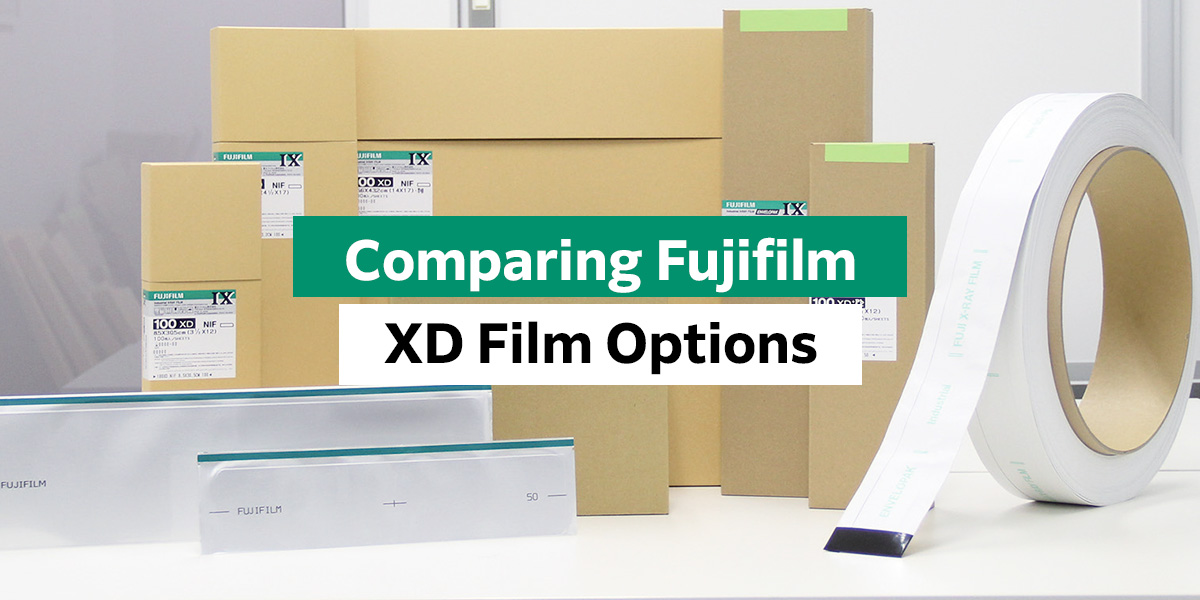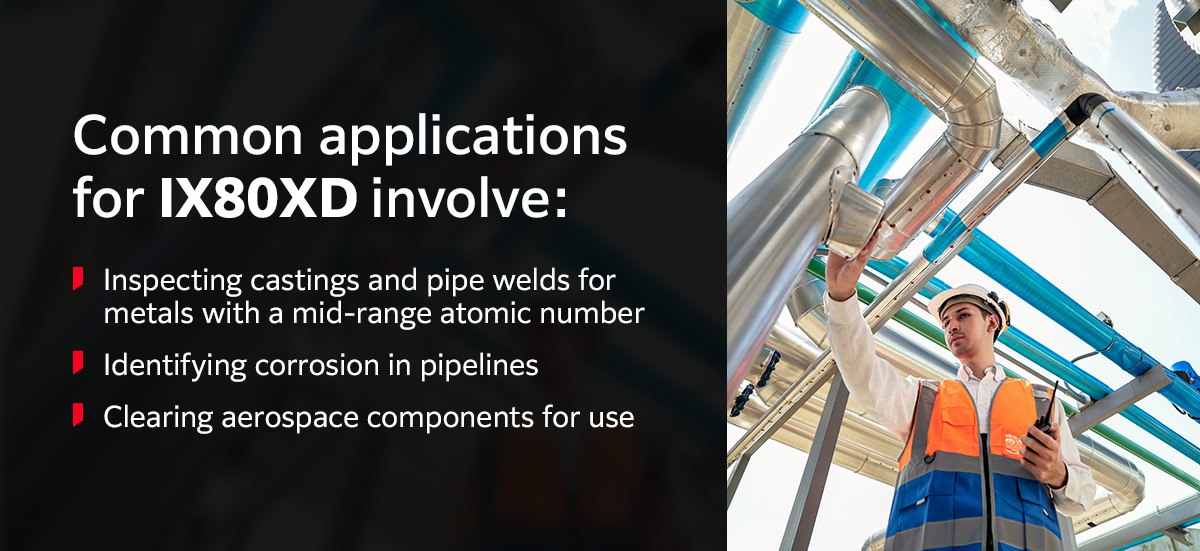Comparing Fujifilm XD Film Options

When you’re testing sensitive materials in highly regulated industries like aerospace or oil and gas, you need to use the right tools. Your X-ray film, for example, is an essential consideration to make.
In this article, we’ll compare the different XD industrial X-ray film options available from Fujifilm so you can decide which one is the best fit for your nondestructive testing (NDT) application.
Why the Right Film Is Important for NDT
Here are some of the main reasons why it’s so important to choose the correct film for your NDT application:
- Image quality: High-resolution, high-contrast film is essential for making defects stand out in the resulting images.
- Exposure time: Using the right film for your purpose can help you limit exposure times, reducing the risk of radiation damage to your film or your test object. The XD series provides consistently fast ISO speeds for rapid imaging with high-quality results.
- Compliance: The film you use should adhere to the relevant standards and regulations for your application. This requirement ensures consistent operator safety and excellent quality assurance.
- Processing requirements: When your film matches your equipment and application, you can simplify your processing workflow for efficient, consistent results.
- Ease of analysis: Using the right film can raise your contrast-to-noise ratio (CNR), making it easier to differentiate and analyze defects during testing.
Fujifilm XD Film: IX50XD vs. IX80XD vs. IX100XD
The new line of XD films for nondestructive testing is excellent for various applications across the oil and gas, aerospace, energy production and manufacturing industries.
Every option in Fujifilm’s XD film lineup provides:
- Unparalleled image quality: The fine granularity of our XD films deliver high-resolution, high-contrast images that make it easy to detect even the smallest defects.
- Consistent results: The XD line provides the industry’s most dependable batch-to-batch consistency, enabling you to develop high-quality images with reliable exposure times.
- Even surface density: Our advanced emulsion coating creates a consistent surface density on the film, which provides bright, clear, high-quality images for more accurate analysis.
The subtle differences between each film type mean that understanding the requirements of your specific application is critical for making the best choice. With this knowledge, you can determine which film meets your specifications and identify the most appropriate ways to use it.
Here, we’ll compare each item in our XD film line to help you find the right fit for your application.
IX50XD
IX50XD features an ultra-fine grain, which provides sharp, high-definition images for effective detection. It has an ISO speed of 125, making it the least sensitive film in the lineup.
IX50XD also falls under the following industrial radiographic film categories:
- ISO 11699-1 C3
- ASTM E1815-96 Class I
- JIS K7627 T2
As a result, it’s an effective gas and oil XD film for use with applications involving low-atomic number metals and low energy outputs. It’s also generally used with lead screens to prevent radiation damage. Some example applications include:
- Inspecting pipe welds
- Identifying corrosion and erosion in metal pipes
- Examining castings
- Testing electronic components
- Inspecting turbine blades for power generation
Essentially, IX50XD is ideal for any low-intensity NDT application where fine detail is critical.
IX80XD
This fine-grain, high-contrast ASTM Class I film is an excellent middle-ground between IX50XD and IX100XD. Its ISO speed of 160 makes it more sensitive than IX50XD, which means it can capture more minute details for more intensive examination.
IX80XD falls under the following industrial X-ray film classifications:
- ISO 11699-1 C4
- ASTM E1815-96 Class I
- JIS K7627 T2
Typically, IX80XD should be used with lead screens for safe operation, but you can use other screen types for some applications. It’s best for use with a low-energy radiation source and materials with a low to medium atomic number, though IX80XD is also suitable for testing materials with higher atomic numbers and higher-energy X-ray sources.

Common applications for IX80XD involve inspecting castings and pipe welds for metals with a mid-range atomic number, identifying corrosion in pipelines and clearing aerospace components for use.
IX100XD
Our last XD film option is IX100XD. Featuring an ISO speed of 250, IX100XD is the most sensitive of the three. This characteristic makes it suitable for inspecting thick, high-density specimens with high-energy X-ray sources. While you can use fluorescent or fluorometallic screens with IX100XD, lead screens or direct exposure are the most common choices.
IX100XD falls under the following regulatory categories:
- ISO 11699-1 C5
- ASTM E1815-96 Class II
- JIS K7627 T3
The ideal testing material for IX100XD film is a light metal with low-activity radiation sources, but you can also use it to inspect heavier materials with high-energy radiation. Some example applications for IX100XD include:
- Inspecting welding strength
- Clearing aerospace components for use
- Testing castings
With IX100XD, you can achieve clear, high-contrast images with shorter exposure times, which is ideal for highly intensive testing applications requiring detailed scans.
How to Determine Which XD Film You Need
Before you begin testing, you need to decide which XD film you will use for your application. Some of the factors that have the biggest impact on choosing a type of film for NDT include:
- Material properties: The thicker and denser a material is, the more sensitive your film should be.
- X-ray sources: Depending on the energy level and type of radiation you will use for the test, the type of film you need will change.
- Testing standards: You may need to use a specific type of film to comply with testing standards and regulations unique to your industry. All three XD films comply with the ISO, ASTM and JIS standards for their classification.
- Expert recommendations: The original manufacturer of your X-ray system may provide film specifications in the owner’s manual, which can help you narrow down your options to find the best fit for you.
The type of film you use will also impact your specific processing requirements, such as your exposure times and processing chemicals. For example, you may need to use more processing materials to develop film that isn’t the optimal choice for your application — and this excess can result in lost revenue and a higher environmental footprint.
Get Superior NDT Images With XD Films by Fujifilm
Trust the professionals at Fujifilm to help you elevate your radiographic NDT operations. We have decades of experience in the industrial radiographic testing field, so you can count on us to provide the highest-quality materials for effective testing — and the XD range is our latest industrial X-ray innovation. Browse our selection of XD X-ray films here to learn more.
If you still need help deciding between your options, feel free to contact us. Our experts will help you find the best fit for your application.











